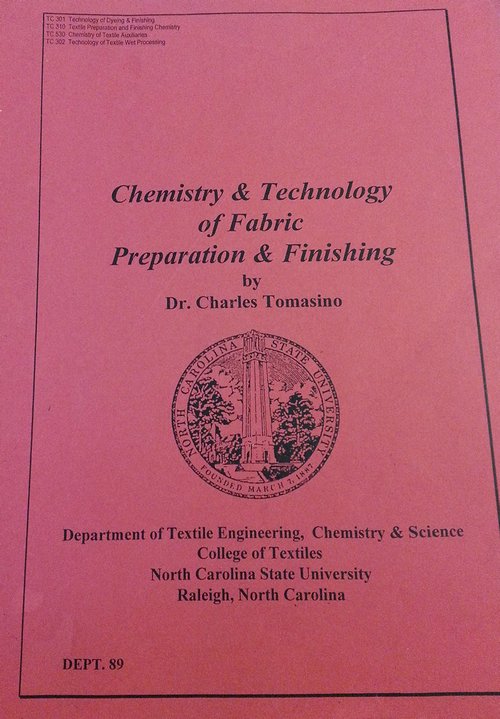
Table of Content
Part I: Fabric Preparation
Preparation processes
Chemistry of yarn and fabric preparation
Scouring
Bleaching
Other processes
Part II: Fabric Finishing
Mechanical aspects of chemical finishing
Durable press finishes
Hand modification
Repellent finishes
Soil-release finishes
Flame retardant finishes
Other finishes
Mechanical finishes
PREFACE
Global competition has caused the US textile industry to modernize and become cost competitive because developing nations have discovered that exporting textile products to the USA is an attractive way to enhance their economic growth. Their low labor costs have pressured domestic producers into replacing labor intensive manufacturing equipment with automated, sophisticated, efficient, high technology machinery. The industry has focused on reducing costs, improving quality and developing quick turnaround and response scenarios. These forces have impacted the number and quality of the technical work force. Graduates with a background in computers and information management are making up a larger portion of the entry-level technical staff. Process engineers dedicated to improving quality and efficiency make up the rest. Most of the entry level work force has little or no exposure to textile education or training, they have to rely on experienced technologists to guide and train them. Unfortunately as the older technologists retire, they take with them valuable technical knowledge and know-how leaving the skeletal remains technically unsupported. Most of the technical information is in the form of supplier technical bulletins or in the files of one or two key old-time technologists. Very little is in written form, and what does exist, is not easily accessible to others needing the information. The new-hires are expected to perform their job assignment without the benefit of having trained under a technologist who understands the fundamentals of the process.
There are many references dealing with the subject of textile wet processing. Some are text books describing particular aspects of bleaching and dyeing. There are also a few volumes describing chemical finishing. These books, while filled with valuable information, are old and limited to fibers, fabrics and processes important at the time they were written. Some up-to-date information can be found in specific, single topic papers or bound compilation of research and technical conferences papers. Other sources are specific technical support bulletins issued by chemical or fiber companies. The literature is devoid, however, of books that survey the whole field in one volume and stress fundamentals rather than specific recipes and procedures.
The idea for this book started with the need to provide students in textile chemistry written material to support courses in dyeing and finishing, in particular fabric preparation and fabric finishing. I was disappointed that there was no single volume reference book which adequately covered the information I deemed important. In the beginning, course material was a compilation of class notes gathered from a multitude of sources. It soon became clear that a more complete, written monograph was needed to adequately convey the important chemistry and technology. There have also been numerous requests from industrial contacts for single volume reference material for people entering the field.
At the urging of my colleagues and industry peers, I have been persuaded to publish this collection of information so that anyone may have access to it without the laborious and time-consuming efforts required of me. As a reference source, I have used published information where possible. The book is arranged in two parts, preparation and finishing. In both sections, I have attempted to describe both the mechanical and process parameters, as well as the underlying chemistry behind each process. The major focus in describing the underlying chemistry is the fiber/chemical interaction; however, where possible, I have provided a brief review of the appropriate chemistry behind the various classes of chemical auxiliaries. Each part of the book is subdivided into a part that describes equipment and a part that describes unit operations. Some attempt is made to describe the stages in sequence, one that a typical greige fabric may follow. However, it is important for readers to understand that there is no one single correct way to perform textile wet processing. Each dyehouse has its own character, depending largely on the type of equipment and type of fabric it processes. This makes the selection of operating parameters dyehousespecific and one may be faced with having to select from several options to achieve the desired end-product. Regardless of which option selected, the same final fabric properties must be met. To this end, I have stressed the objectives and fundamentals of each process. It has been my opinion over the years, that those operations with a technical staff well grounded in the fundamentals, ran more smoothly than one who relied on trial and error as a means of setting up their process.
Fabric preparation has been subdivided into singeing, desizing, scouring, bleaching, mercerizing, carbonizing and heat setting. Finishing is broken down into chemical and mechanical. Chemical finishing covers those treatments that alter the performance of the textile fabric where the chemical is the major component of the change. Mechanical finishing refers to certain types of mechanical devices that physically alters the fabric.
Contributing to the existence of this monograph is the age of computers and word processing. I would have never undertaken this task without the convenience and ease of compiling and moving the information about, something I would have never done by hand. It is my sincere hope that you will find the book valuable, and I welcome comments and suggestions for future revisions.
Charles Tomasino
